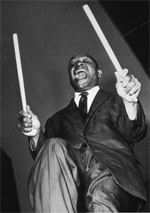
October 18, 2006
Hamp & slow-mid range swing
Posted by dogpossum on October 18, 2006 10:42 AM in the category digging and lindy hop and other dances and music
 My love for Lionel Hampton continues in an unnatural way*. Unnatural in that I have not only abandoned my qualms about DJing jump blues for lindy hoppers for Hamp's sake, but in that I have also decided that boogie woogie is Fun. I have also (quite unashamedly) overplayed my favourite Hamp songs (eventually, I guess, I will tire of songs like Drinkin' Wine spo-de-oh-doh, Hey ba-ba-re-bop! and Lavender Coffin (yes, despite all evidence to the contrary, they are actually different songs)) and will continue to do so.
My love for Lionel Hampton continues in an unnatural way*. Unnatural in that I have not only abandoned my qualms about DJing jump blues for lindy hoppers for Hamp's sake, but in that I have also decided that boogie woogie is Fun. I have also (quite unashamedly) overplayed my favourite Hamp songs (eventually, I guess, I will tire of songs like Drinkin' Wine spo-de-oh-doh, Hey ba-ba-re-bop! and Lavender Coffin (yes, despite all evidence to the contrary, they are actually different songs)) and will continue to do so.
I think my love for Benny Goodman's small groups is in part (perhaps a large part) owing to my love of the Hamp.
Right now, I am declaring a love for Don't be that way (you can hear it here). I have already played it far too many times, and will continue to do so. I just love the way it chuggs along. And you get the feeling that there's some joking going on in the band there. I love the saucy brass with the brruurp brruurp trombone underneath. I love the twinkly vibes. I love the chunky beat (bass, guitar esp). I even love the sax (and really, who could love sax?). I love the restrained, but kind of bursting-at-the-seams feeling of momentum building. It's only 137bpm, but it feels like it's going somewhere.** It feels like... like... like bounce feels - like energy stored in your body, that might bust out any old how.
This brings me to a comment another dancer made the other day. After I'd just played a set of old scratchies that were all between 120 and 167 at a sedate after-class gig.
The comment involved these points:
- I wish that guitar would move away from the microphone. It's so dull - clunk, clunk, clunk
- that older clunky music sucks when it's under 180 - it's really boring.
I didn't really lay much value on these observations.But it made me think a lot about the issue (of course). And here are the things I came up with:
- that slower stuff sounds dull if you're looking for tinkly, complex melodies and delayed timing, a la Oscar Peterson. But if you're into combining moves, and working with phrases as the markers for your complexity (ie, working on a larger scale), or perhaps looking at the layers of sound only a big band can offer, and which are clear markers of that earlier, late 30s sound, then this stuff is quite interesting. It begs a combination of moves and a use of lateral or horizontal space, rather than micro-movements on the spot. It says 'think of each note or each beat or each chunk of rhythm as part of a bigger pattern' not 'think of each note or beat or chunk of rhythm as something you have to echo in your body exactly'.
The free-er, riff-based and improvisation-heavy nature of Kansas City jazz (in particular) encourages musicians to think of how they can combine improvisations and solos within a looser musical framework. For dancers, that approach encourages contributions to the rhythms going on, rather than a strict representation of what they can hear. So, for example, a Swede would add a bit of syncopated footwork at the end of an 8 to add rhythm to the song, rather than simply making flesh exactly what they can hear. They would also make greater use of a dynamic, lateral energy rather than just a restrained, micro-movement and energy-contained.
So, really, this stuff is actually very interesting and challenging for dancing. Even at slower tempos. I actually feel that slower tempos can offer greater scope for improvisation and interest - you have time to add stuff in. When you're moving to 200bpm, you don't have time to add in extras - you pare down the movement to basic moves simply because you don't have time. It's about combinations of moves rather than individual movements.
When you're working at a slower tempo, you can add in all the interesting visual 'commentaries' and social interaction that faster tempos prevent. And if you're working with the more open, improvised connection of a Swedish or old skool swingout, for example, both partners can happily add in variations and jazz steps, breaking out into open to do 'solo' stuff as well. And all that in addition to the combinations of moves and use of lateral space that says 'hey, I can hear more of this song than just the three or four notes in my immediate vicinity'.
I also find that phrasing becomes more important with this sort of music - you work in combinations of 8s rather than within an 8 for variation and interpretation and improvisation.
So my love of the mid/slower tempo chunk-chunk songs by people like Lionel Hampton run in the face of arguments challenging their aural interest. But I must admit - 120 is the lowest I'll go in that style, and really, it's better if it hits 140.
*a love that will never be realised as this fan's was here
**a lot like the slower version of Flying Home that's about - it builds to a frenzy of almost-fastness. It's at least 20bpm slower than the version most dancers know.




